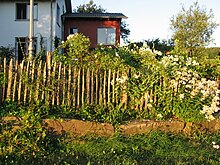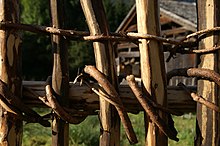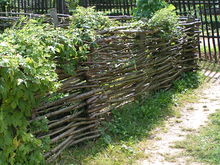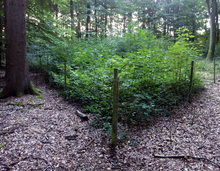fence
A fence is an enclosure . It separates two areas permanently or temporarily by a man-made border . If this is done specifically to enclose animals, it is also called a gate or pen .
A fence is usually made of wood, metal ( solid cast or wrought iron , or flexible wire) or plastic. Boundaries made of stone or concrete are called walls ; The gabion wall occupies a middle position between the fence and the wall . Occasionally fences are also painted, glazed or varnished, modern wooden fences are usually impregnated , wire fences are often plastic-coated. Frequently used robust types of wood are chestnut , larch , oak , pine or flexible - and cheap - such as spruce and willow .
Unlike a wall , however, it is in principle transportable and has limited permeability. The clearly defined demarcation separates it from an obstacle, barrier or barrier, even if the terms are occasionally used synonymously .
Etymology of the word fence
The German word fence is related to the English word town " Stadt " and the Low German / Dutch word tuin "Zaun", "garden". So it originally did not designate the obstacle itself, but the area enclosed by it. The old German word Hag , which denotes a fence made of living material, the hedge , as well as made of pole wood , and the word field garden , gate for the wattle fence, are analogous to fencing and the land protected by it . In addition, there is also the word " enclosure" as well as the root biunta (see field name etymology ).
Use of fences
On the one hand, a fence is used to identify pacified properties and thus domiciliary rights. On the other hand, fences are used to prevent people and / or animals from moving into or out of an area, e.g. B. pastureland, in zoos, prisons or camps.
As a border fence, it can also serve to demarcate state territories, e.g. B. on the former inner-German border between the Federal Republic of Germany and the GDR . The 700 km long barrier along the Green Line in Israel, which separates the Israeli core area from the West Bank , is currently called "Grenzzaun" "or" Sicherheitszaun ", which as a political name has a euphemistic character.
Companies use fences to secure their commercial and industrial areas against unauthorized persons, as do private individuals to secure their properties and gardens. They are also used in landscape protection areas. In road construction, toad fences are built near the hiking trails to protect amphibians. In addition, the fence is used to hide a certain object from the eyes of unauthorized people in public.
A structure in closed spaces that is related to the fence is called a grid . It is not uncommon for the fence to be used for decorative purposes, e.g. B. as a climbing aid in garden design.
Rules for fences
Fences are often required with a certain minimum height and a certain minimum distance to the object in general. Maximum openings to prevent reaching through or climbing through can also be prescribed.
- with open high-voltage systems ( substations , self-radiating transmission masts ). Substations are usually surrounded by metal fences with barbed wire on them. This metal fence must be connected to the station earth so that no dangerous voltages can occur. Wooden fences are often used for fencing in self-radiating transmitter masts to avoid eddy current losses . However, trams electrified with busbars do not have to be completely fenced in.
- when securing construction sites as a site fence or site fence
- for systems with dangerous moving parts ( e.g. rides in amusement parks)
- at explosives factories and warehouses
- at quarries
- in most industrial plants
- at airfields
- in military areas, where training areas are usually not completely fenced
- at prisons
- at zoos and animal parks
- during various leisure activities (e.g. paintball)
- Open-air areas which you have to pay an entrance fee to visit
The regulations of the municipalities for the installation of private garden fences are not uniform.
Different types of fences
The oldest types of fences were wattle fences and picket fences , as they are still used today in traditionally tended cottage gardens. They were used to lock animals out or in.
Just as different house types can traditionally be found in every landscape, different fence shapes have emerged around the world, some of which help shape the image of a landscape. In the times of the " Wild West " of the USA , fences played an important role in delimiting the ownership of the huge herds of cattle. The fences, which had been provided with barbed wire since the 1870s, even led to grazing wars .
The custom of fencing off the entire property in settlements has its origin not in Germany but in England. Originally the pastures and the garden itself were fenced off. Other cultures, e.g. B. in Ireland, their properties are demarcated for various reasons with dry stone walls , others with hedges or moats . For centuries, windbreak hedges built on small walls have crossed the country in Schleswig-Holstein. These are referred to as " kinks " and ensure an excellent microclimate. Mostly shrubby deciduous trees are used. There are also small regions in Germany that deliberately do not put fences: The residents of the old fishing village of Neuendorf on the Baltic Sea island of Hiddensee are proud to this day that their properties have not been fenced off from time immemorial. Depending on the application, a different type and size of fence is used:
According to material and construction
chain-link fence
The chain link fence or diagonal wire mesh fence consists of posts and wires . The wires are woven into meshes. A post is anchored in the ground at defined intervals and wires are stretched between these posts. The density of the wires depends on the purpose of the fence. Coarse meshes hold back large creatures, fine meshes also hold up smaller ones.
Metal fence
The metal fence or grid mat fence or double wire mesh fence is made of steel or aluminum. The metal rods can be solid, square or rectangular, but they can also be woven into curved patterns. Wrought-iron fences in the most varied of designs, which used to be built mainly on more representative buildings, still play a role as genuine forged external elements at best as historical building spare parts because of the costs. However, the market has taken on a niche role from industrially preformed elements to be welded together to form 'wrought iron' fences.
In the case of a wire mesh fence made of steel wires, a distinction is customarily made between single rod mats, double rod mats (grids) or triple grids. In the case of single rod mats, one horizontal and one vertical steel wire are welded together, and with double rod mats two horizontal and one vertical steel wire are welded together. In the case of triple grids, an additional third horizontal bar on the inside of the terrain results in a cable run which i. d. Usually used for detection purposes.
Both wire and metal fences are now usually galvanized to protect against corrosion , and increasingly also colored powder-coated . Privacy strips woven into the bars are becoming increasingly popular, especially in private areas. This means that an area cannot be seen from the outside, the color of the fence or the area / building to be protected can be adapted and also serves as a wind protection. With the help of so-called edging profiles, it is also possible to combine different colored privacy protection strips within a fence and to close an integrated swing gate from view.
Picket fence, picket fence
The picket fence consists of vertical slats, which are connected to one another by two or three transverse bars (bars). Slats are attached to these crossbeams at regular intervals. The cross-section of the wooden slats is rectangular, the aluminum slats are tubular.
Special designs allow the tubular aluminum slats to resemble the (lacquered) wooden slats, but to shine for much longer and to be almost indefinitely durable. The aluminum slats are screwed, welded or riveted to the transom. Aluminum slats can also be made powder-coated with wood decor. Due to the special design of the bolts, the screw heads (or rivet heads) are covered with an integrated strip and are not visible from the front or the rear.
The aluminum slats are usually closed on top with attached or inserted caps. These caps are made of zamak alloy (zinc alloy) or cast aluminum. The advantage of the zamak design lies in the precise fit, but the production is expensive due to the relatively high tool costs. Cast aluminum is cheaper, but mostly imprecise and porous due to air pockets. When powder coating , these pores often make bubbles. After drying, these flaws are visible. Zamak caps usually have no pores, so the coating usually has no defects.
An older form of picket fence is the picket fence . The cross section of the stakes is tubular or square, bevelled at the top. In contrast to the picket fence, the stakes are attached to a lower and an upper cross beam.
The picket fence made of chestnut wood ( sweet or sweet chestnut , Castanea sativa ) has been manufactured in France and England for many years. As a chestnut fence, picket fence or roll fence, this fence has become more and more popular in Germany in recent years. The specialty of this picket fence is the connection of the individual split pegs with galvanized wire. Due to the connection with wire, the fence adapts to any terrain. The fence is used wherever a natural look or a durable, easy-care and therefore inexpensive fence is desired. The picket fence is delivered in heights of 50 cm to 200 cm. For laying, stakes are driven into the ground and then the fence is attached to the wire with staples. The fence is more durable (due to the high tannic acid content of the chestnut) without painting than conventional pressure-impregnated fences. The sweet chestnut is cut every 10 to 20 years and then comes out of the hive again.
The Hanichl fence is an old form of fence that used to be common in Bavaria. It is made from spruce or fir trunks cut in half and pointed at the top.
Hunter fence
The hunter fence , also known as a scissor fence or a cross fence, is still very popular in some areas when building private houses. It is particularly common to meet him in closed settlement formations. In this fence, which is around 80 cm high, the laths, which are pointed at the top, are attached to two cross beams next to each other in an X-shape.
Closet fence
The cabinet fence, which in some places is also called the Sarner Bettlzaun, Knüppel-, Schrä-, Schar-, Graggenzaun (Switzerland) and Scheia- or Schrag (g) azaun ( Montafon / Austria) is a pasture fence, which is mainly in the forest - and alpine pastures is built.
This is mainly because it can be erected and removed again relatively quickly, which is a great advantage, especially in areas prone to avalanches. In the case of the "closet fence", pairs of sticks approx. 1.5 to 2 m long are knocked into the ground in such a way that they form a pair of scissors (in the vernacular "crowd") into which approx Slats are inserted. Round poles up to 4 m in length are also used in some areas. In the vicinity of forests, tree tops and branches are also used as inlay wood.
Spelten fence
In the case of a braided fence, also known as a whip, wicker or picket fence, the rammed into the ground (vertical fence timbers) are tied with spruce branches or willow strips to the crossbars or poles supported by pillars. The rafters are split out of a larch trunk and should also be tapered towards the top. They can also be made of boards or rinds . The height of the fence is 1.50–1.70 m. That part of the posts that is hammered or dug into the earth must be burned to prevent rot.
Picket fence
The palisade fence, also known as the lance fence , is also aligned vertically and attached to two crossbars. The individual palisades have a round or tubular cross-section and are pointed at the top, which makes them extremely dangerous and occasionally a fatal trap, especially for climbing children.
Plank fence
The plank fence is a particularly opaque fence in which the individual planks or slats are offset on one or both sides.
Wooden fence
Wooden fences are mostly used as a privacy screen z. B. at construction sites, used or as protection against property damage. Boards are attached between the individual posts.
Wicker fence
The braided fence made of flexible profile boards horizontally or vertically interwoven is one of the oldest fence forms and looks very natural; classic wood is willow.
Ring fence
The ring fence, also Rautenhag or ribbon fence, is made without nails. The boards are connected to the posts with rings made of fir or larch branches .
Concrete fence
Concrete fences - a system consisting of posts (double T-beams) and panels. Solid or perforated concrete slabs are used between the cast-in posts. In the case of solid panels, there is no transparency as an essential character of a fence. Since, in contrast to a wall, there is no complete foundation and the solid panels can also be exchanged, this type of demarcation can be assigned to the fences. However, since concrete walls are difficult to market, the systems are offered by manufacturers under the term "concrete fence". This type of "fence" is very robust and, depending on the type of fence, offers privacy and noise protection. The service life can be up to 30 years and more. A distinction is made between one and two-sided patterns. In the case of one-sided panels, there is the option of mounting back to back by using double groove posts. This also creates a structure on both sides. The service life, extensive maintenance freedom and weather resistance of this fence system is superior to other materials.
Electric pasture fence / electric fence
The electric fence consists of wires or (for better visibility) colored, wire-drawn plastic strips through which current pulses flow at short intervals. These give animals an unpleasant but not dangerous electric shock when touched . To deter predators , electric fences are recommended for herd protection .
After application
Pasture fence
The pasture fence is used where you want to fence animals in a pasture . It is not to be confused with a wicker fence made of wicker . Mostly round posts made of spruce / fir with semicircular slats made of the same material, or durable acacia wood, are used for an electric fence . The height of the fence for horses should be around 150 to 160 cm. Pasture fences should not only prevent the grazing animals from escaping, but also prevent predators from tearing the grazing animals down ( herd protection ).
Wild fence
The game fence, also known as the game protection fence, consists of knotted wires with rectangular meshes that get tighter and tighter from top to bottom. The fence is used to protect against game damage in the forest as well as on motorways and federal highways to protect road users from accidents with wildlife . Other names for this fence are knot mesh, forest mesh, knot grid, game fence, pasture fence, cattle fence, sheep fence / sheep mesh, highway fence or dog fence.
Site fence
A site fence is the temporary demarcation, barrier or protection of any location. In the event that it is used to secure a construction site , it is part of the construction site facility .
Ball catcher
Ball catchers are protective measures that are mainly used on sports fields and gyms to protect spectators, but also systems, walls and equipment. Their function is to intercept and brake balls that are used in ball sports such as volleyball , soccer or tennis and that could leave the field of play at high speed or if the shot is too far. Ball catchers, ball catcher fences or ball nets are made of strong threads, ropes, wire mesh or steel grids that are attached to sturdy posts.
Anti-glare fence
A glare protection fence is part of the street equipment and serves to reduce or prevent glare from oncoming vehicles in traffic. Glare can in some cases severely restrict the driver's field of vision and thus endanger road users. For this reason, the first attempts with anti-glare fences were made as early as the 1960s.
garden fence
The garden fence serves to delimit the garden of a property from the neighboring properties and the traffic areas.
Fish fence
The fish fence , also fish groyne, agge or arge (English called fish weir or fish trap ) is a device for passive fishing that has been used worldwide since the Mesolithic in rivers, lakes and suitable coastal areas. Mass trapping in the vicinity of seasonal living spaces can be assumed in Europe since the Mesolithic. The residents of rivers, coasts and lakes enriched their diet with fish after the departure of the large herd animals.
FIA fence
An FIA fence is a barrier element on racetracks that is intended to protect people behind it from parts that fly around in a collision. Usually it is located on both sides of the racetrack, above the (three or fourfold) guard rails and any energy absorbers such as tire stacks.
Snail fence
Snail fences are a measure used to prevent snails from entering certain areas.
Protective fence
A protective fence is an artificial barrier to shield larger areas from harmful environmental influences.
Windbreak fence
A windbreak (. English blast deflector fence ) is a building on airfields , which serves people, vehicles and objects from the harmful effects of the air jet of jet aircraft (English: Jet Blast ) or propeller engines (English: Prop Wash ) to protect. They also serve to prevent damage to the aircraft that could result from the recirculation of the air jet.
Sage gate
A wise man's area , also known as a wise man's fence, control fence or wise man's gate, is an area that is fenced off game-proof and used in forestry science and management.This area is used, by comparison with a non-fenced area outside, to assess the influence of game (especially deer in Central Europe, e.g. Partly also red deer, fallow deer and sika deer as well as chamois and mouflon) on the natural regeneration of the forest and to be able to adapt the hunt accordingly. The influence of game on the vegetation is used as an indirect indicator of the local game density.
Safety fence
Safety fences are (additional) fall protection on rock edges.
Others
Construction fences or fences in places where people often pass are occasionally used as supports for advertising and information posters. Relevant warning signs can often be found on the fences surrounding dangerous facilities such as substations.
In German cultural history of the fence, especially in the form of the garden fence, often equated with petty bourgeois smugness . Together with the garden gnome , critics also see him as a synonym for righteousness and petty possessiveness: a dispute at the garden fence among neighbors was the cause of numerous civil lawsuits and provided material for television programs. Stefan Raab's song Maschen-Draht-Zaun about a neighborhood dispute had cult status for a while in 1999. Others, on the other hand, see the garden fence as a symbol of cosiness and domestic harmony.
- At 5400 km, the dingo fence in southeast Australia is the longest fence in the world. The Rabbit-Proof Fence in Western Australia is the second longest at 3,256 km.
- The shortest fence in the world was produced in 2005 by the researchers Seth Marder and Joseph Perry using a new type of microtechnology process , two-photon 3D lithography , for demonstration purposes. It is about 200 micrometers long and 50 micrometers high and consists of three rectangular chain links and two posts.
- The songwriter Stefan Stoppok dedicated his song The Little Fence to the show with the mouse in 1996 .
- The " Bra fence from Cardrona " in Cardrona , New Zealand is considered the most bizarre and famous fence in the world. The fence which now has over 1,000 suspended bras has become a tourist attraction.
See also
literature
- Nicole Andries, Majken Rehder: Fence worlds, fences and contemporary witnesses - stories about everyday culture in the GDR. Jonas, Marburg 2005, ISBN 3-89445-343-5 .
- Heinrich Beck , Ruth Schmidt Wiegand , Roland Schuhmann , Heiko Steuer , Dieter Strauch : fence . In: Reallexikon der Germanischen Altertumskunde . No. 34 . de Gruyter, Berlin / New York, NY 2007, ISBN 978-3-11-018389-4 , pp. 446-476 .
- Martina Rahner, Jörg Schierwagen: Fences, Walls, Hedges: Design on the edge of the property. Callwey , Munich 2011, ISBN 978-3-7667-1878-5 .
- Georg Müller: Europe's field enclosures. Wall hedges (Knicks), hedges, field walls (stone walls), dry shrub hedges, flexible hedges, wattle hedges, wicker fences and traditional wooden fences, dry shrub hedges, bending hedges, wattle hedges, wicker fences and traditional wooden fences (original title: Europe's Field Boundaries ). 2 volumes, Neuer Kunstverlag / Neuer Sportverlag, Stuttgart 2013, ISBN 978-3-944526-14-0 .
- Moderne-regional.de : Closed society , issue 2/2020.
Web links
- Service page of the Vienna Environment Agency ( Memento from September 29, 2007 in the Internet Archive )
- Entry on historical fences in Upper Austria in the Austria Forum (in the Heimatlexikon)
Individual evidence
- ^ Peter Liptau: The hunter fence. In: Moderne-regional.de. April 4, 2020, accessed April 16, 2020 .
- ↑ The Secret of Nailless Fences (September 27, 2014)
- ↑ Hunters demand more game fences
- ↑ Ball catcher. zäune.de / lexikon /, accessed on November 7, 2013 .
- ^ Course of the dingo fence
- ↑ 3D Chemistry: Fabrication Technique Uses Light-activated Molecules to Create Complex Microstructures. ( Memento of the original from November 24, 2005 in the Internet Archive ) Info: The archive link was automatically inserted and not yet checked. Please check the original and archive link according to the instructions and then remove this notice. February 16, 2004.















